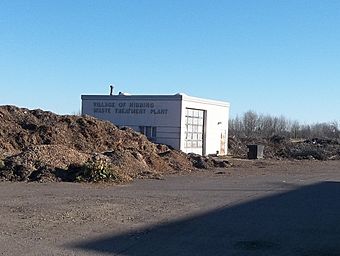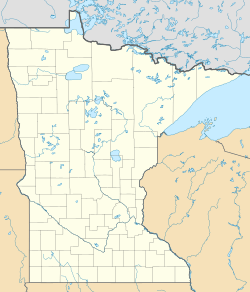Hibbing Disposal Plant facts for kids
Quick facts for kids |
|
|
Hibbing Disposal Plant
|
|

The 1970 Grit House at the Hibbing Disposal Plant
|
|
| Location | 1300 East 23rd Street, Hibbing, Minnesota |
|---|---|
| Area | 12 acres (4.9 ha) |
| Built | 1938–39 |
| Built by | Roberts and Schaefer Company |
| Architect | J.C. Taylor, Public Works Administration, Charles Foster |
| Architectural style | Moderne |
| MPS | Federal Relief Construction in Minnesota, 1933–1941 |
| NRHP reference No. | 91001022 |
| Added to NRHP | August 9, 1991 |
The Hibbing Disposal Plant, later called the North Wastewater Treatment Plant, was a special building in Hibbing, Minnesota. It was built between 1938 and 1939. Its main job was to clean dirty water from the city. This helped keep Hibbing healthy and clean.
This plant was a big project by the Public Works Administration (PWA). The PWA was a government program during the Great Depression. It helped create jobs and build important things across the country. The Hibbing plant was listed on the National Register of Historic Places in 1991. This means it was recognized as an important historical site.
Contents
Cleaning Up Hibbing's Water
The Hibbing Disposal Plant was a very important part of the city's health. Before plants like this, dirty water from homes and businesses often went straight into rivers or lakes. This could spread diseases and make people sick.
The plant used modern methods to clean the water. It made sure the water was safe before it went back into the environment. This was a huge step forward for public health in Hibbing.
Building During Tough Times
The plant was built during the Great Depression. This was a time when many people didn't have jobs. The Public Works Administration (PWA) was part of the New Deal. The New Deal was a series of programs started by the government.
The PWA hired many people to build projects like this plant. It gave them jobs and helped the economy. The Hibbing Disposal Plant was one of the biggest PWA projects in northern Minnesota.
Amazing Engineering
The Hibbing Disposal Plant was also special because of its design. It had two huge domes made of reinforced concrete. These domes were some of the largest of their kind in the world. They were built to support themselves without extra pillars.
Inside the plant, there were "trickling filters." These filters helped clean the water. They worked by letting the dirty water slowly drip through a bed of rocks or plastic. Good bacteria would then grow on these materials. These bacteria would eat the bad stuff in the water, making it cleaner.
A Historic Landmark
The plant was added to the National Register of Historic Places in 1991. It was important for several reasons. First, it showed how engineering helped solve problems. Second, it improved public health and medicine in the area. Third, it was a big part of Hibbing's social history.
It was a great example of how the New Deal helped communities. Many towns got modern sanitation facilities for the first time. The plant's unique domes and its impact on Hibbing's health made it a significant landmark.
What Happened to the Plant?
In the early 2000s, the city of Hibbing stopped using the disposal plant. By 2012, the city received money to tear it down. Most of the original buildings were removed.
As of 2018, only a few newer buildings from later in the 20th century remain on the site. The historic parts of the plant, including its famous domes, are no longer there.



